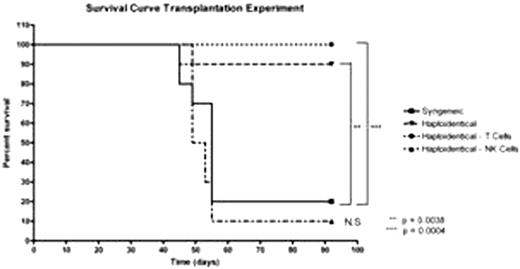Abstract
Abstract 4082
Poster Board III-1017
Patients with metastasized solid tumors can not be cured by current standard treatment options. One hypothesis is that slow cycling chemo-resistant tumor stem cells give rise to new tumors after cytoreductive treatment, ultimately leading to chemoresistant tumors. Acute myeloid leukemia tumor stem cells can be killed by alloreactive T- or NK-cells, as patients have a higher survival chance after allogeneic transplantation. In the past we published the curative effectiveness of allogeneic spleen and bone marrow transplantation in breast cancer bearing mice. Our current aim was to study if either alloreactive T- or NK-cells are able to cure these mice. In addition we wanted to know if the tumors contain slow cycling tumor stem cells.
The 4T1 breast cancer cell line was cultured under standard conditions. Fifty thousand 4T1 cells were injected s.c. in the flank of CB6F1 (H-2b/d) mice. At day 12 mice were treated with 2× 2Gy total body irradiation and 200 mg/kg cyclophosphamide (CY), followed by transplantation of spleen and bone marrow cells. B6CBAF1 (H-2b/k) mice were used as allogeneic donors. These donors harbour alloreactive NK-cells towards CB6F1 recipients as determined by an in vivo NK-cell alloreactivity assay. NK-cell or T-cell depleted grafts were obtained from donors injected with anti-AsialoGM1 or a combination of anti-CD4 and anti-CD8 respectively some days before spleen and bone marrow harvest. Tumor stem cells were defined as slow cycling (i.e. label retaining) Hoechst extruding cells. 4T1 tumor cells were labelled with Vybrant CM-Dil (Dil) and then injected s.c. in CB6F1 mice. Fourteen days later tumors were excised. Part of the tumor was prepared as single cell suspension. Subsequently the presence of Dil retaining tumor stem cells was determined by fluorescence microscopy. The other part of the tumor was snap frozen and studied by histochemistry and fluorescence microscopy. For in vitro cytotoxicity testing 4T1 cells were again labelled with Dil and then seeded in 96 well plates at 30 cells/well. Chemotherapeutics were added in the different plates: 4-OH-CY (the active metabolite), cisplatine and doxorubicin, in concentrations far above the lowest maximal lethal dose as determined in MTT assays. Wells were checked weekly for growth and presence of tumor stem cells. Hoechst staining was used in these cultures to underscore that Dil retaining chemorefractory cells are indeed stem cells.
Ninety percent of CB6F1 mice injected with 4T1 breast cancer cells developed a tumor growing progressively to a size that made it necessary to sacrifice them. Growth in mice treated with radio- and chemotherapy only or additionally with CB6F1 spleen and bone marrow cells was delayed for 10 days compared with tumor growth in untreated mice, but the incidence was equally high (90% and 80% respectively). In contrast, but in concord with our previous published results, only 10% of 4T1 breast cancer bearing mice transplanted with haploidentical spleen and bone marrow cells did show progressive tumor growth (follow-up 99 days at the time of abstract submission, p<0.004 log-rank test)). Similarly, mice transplanted with spleen and BM cells from T-cell depleted donors did not develop tumors at all (p<0.004 log-rank test), in contrast to recipients of in vivo NK-cell depleted grafts (90% tumor incidence).
Label retaining tumor stem cells are unmistakably present in tumors at the day of transplantation, evidenced by the presence of a minute number of Dil retaining cells in single cell suspension of the tumor and in tumor tissue sections. More direct evidence for chemo-resistance of 4T1 tumor stem cells is derived by results of in vitro co-culture experiments. When Dil labelled 4T1 cells are plated in 30 cells/well concentration, approx. 25% of the wells contain one or two label retaining cells while the other wells comprise non-label retaining cells only. After incubation with chemotherapeuticals growth is observed only in wells containing a label retaining cell. These label retaining cells are also Hoechst negative.
This report provides the first evidence that tumor stem cells can be eliminated in vivo by alloreactive NK cells resulting in cure of chemorefractory breast cancer. It is also shown in vitro that only tumor stem cell containing tumor colonies resist the effect of various chemotherapeuticals commonly used in oncology as they do in vivo. These results strongly encourage the exploration of clinical alloreactive NK therapy in patients with metastasized solid tumors.
No relevant conflicts of interest to declare.
Author notes
Asterisk with author names denotes non-ASH members.


This feature is available to Subscribers Only
Sign In or Create an Account Close Modal